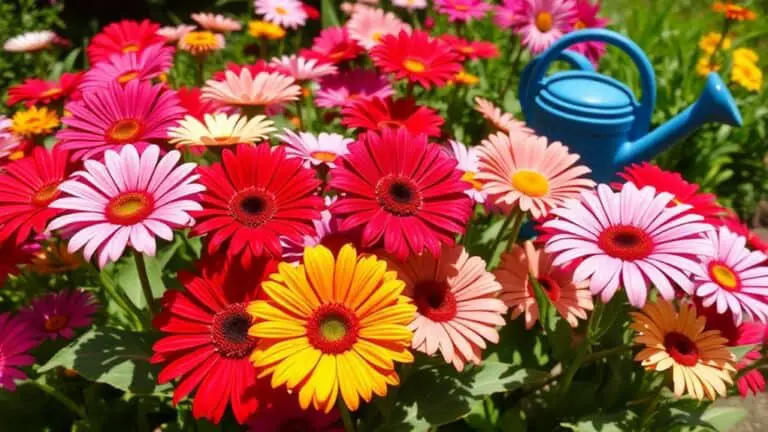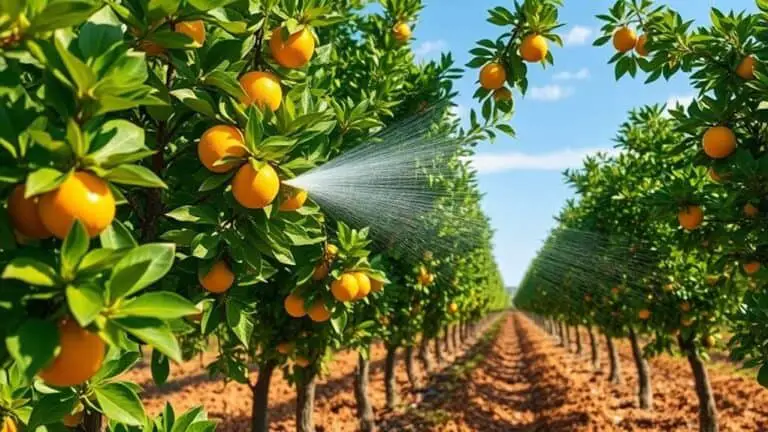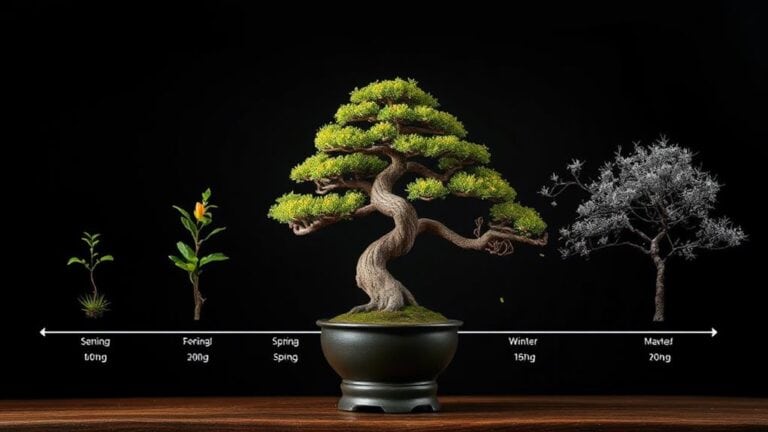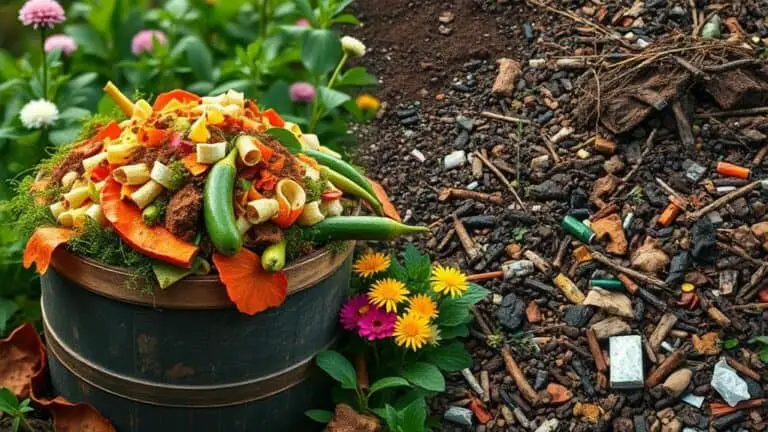What Not To Do In Garden Before Summer Heatwave
As a gardener, I've learned that preparing your garden for a summer heatwave requires strategic planning and knowing what to avoid. It's tempting to plant new flowers or vegetables, but doing so can lead to transplant shock due to the high temperatures. Also, while it might seem like a good idea to water your plants every day, this actually encourages shallow roots, making them more vulnerable. There are other common practices that may seem beneficial but can actually harm your garden during extreme heat. Curious about what else you should avoid? Let's explore further.
Avoid Planting in Summer
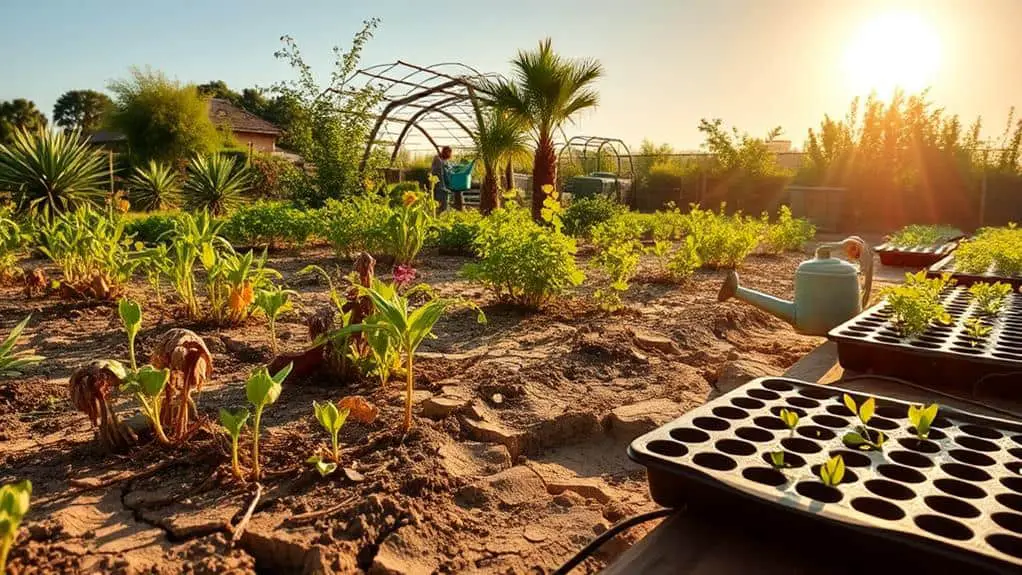
When it comes to planting your garden, steer clear of doing it in the summer. The extreme air temperatures and dryness can make it hard for new plants to settle in.
The best planting times are spring and fall, when the weather is cooler. High temperatures, especially above 90°F, increase moisture loss from the soil, putting stress on new plants and causing transplant shock.
If you plant during summer, you might see foliage loss and poor growth. Instead, wait for cooler air temperatures to guarantee your plants thrive.
Also, consider using mulch to shade the soil and retain moisture. Trust me, waiting for the right time saves you time and effort, and your garden will thank you!
Skip Daily Watering
When it comes to watering your garden, skipping daily watering can actually help your plants grow stronger and healthier.
By soaking the soil every couple of days instead, you encourage deeper root growth, which makes your plants more resilient during hot weather.
Checking the soil moisture with your fingers can help you know when it's really time to water, so your plants stay happy and stress-free.
Encourage Deep Watering
One essential step to ensuring a thriving garden is to encourage deep watering rather than sticking to daily watering routines. When you grab the hose, aim to water deeply every 1-2 days. This helps develop healthier root systems and reduces plant stress. Overwatering daily can lead to shallow roots and higher water bills. Instead, check soil moisture by touching it. If it feels damp, your plants are hydrated. Water early in the morning to minimize evaporation. Adjust your watering based on temperature and plant needs.
| Watering Tips | Benefits |
|---|---|
| Water deeply every 1-2 days | Healthier root systems |
| Check soil moisture by touch | Prevents root rot |
| Water early morning | Reduces evaporation, saves water |
Happy gardening!
Prevent Plant Stress
Skipping daily watering is key to preventing plant stress in your garden. When you water every day, it encourages shallow root growth, making plants more vulnerable during heatwaves.
Instead, soak the soil deeply every 1-2 days. This promotes healthier, drought-resistant plants. Check soil moisture by touch; damp soil means your plants are hydrated.
I also recommend adopting smart plant selection strategies. Choose drought-tolerant plants to reduce water needs.
Enhance your soil with soil amendment techniques like composting, which improves water retention. Consider shade provider options, such as planting taller plants or using shade cloth, to protect delicate plants from direct sunlight.
Water early in the morning to reduce risk of fungal diseases and guarantee plants dry before nightfall.
Hold Off on Pruning
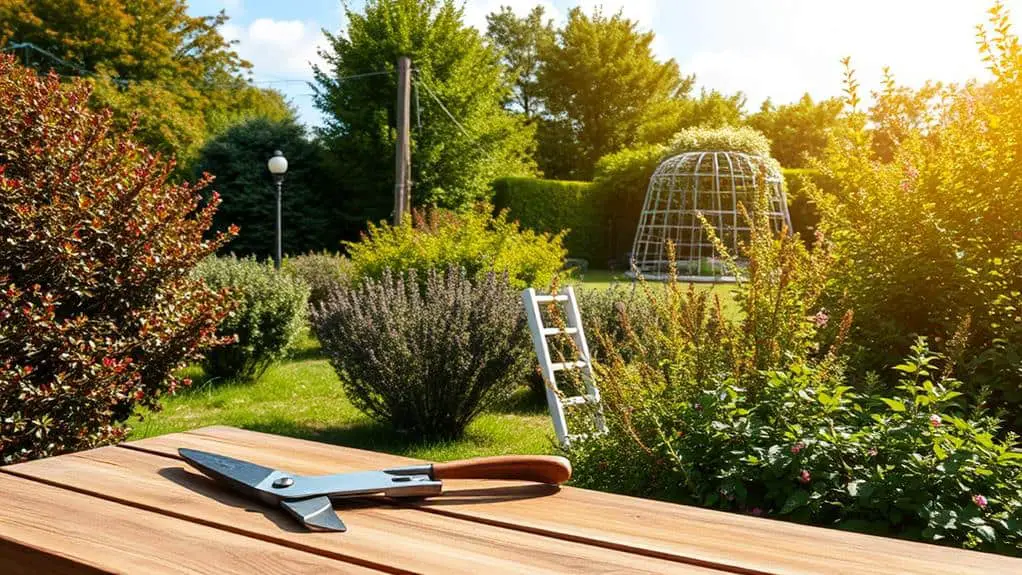
When it comes to pruning, it's best to hold off during the summer heat since it can stress your plants and make them more vulnerable to pests and diseases.
Instead, wait for the dormant season, from January to mid-March, which is the ideal time for promoting healthier growth.
Pruning during the hot months can lead to excessive foliage loss and hinder your plants' ability to thrive, so letting them stabilize first is key.
Attracting Pests and Diseases
Understanding the importance of timing in gardening can be the difference between a flourishing oasis and a pest-ridden mess. Pruning during the summer heat isn't just stressful for plants; it can also attract pests and diseases. When you cut branches, sap flows out, drawing in insects and making plants more vulnerable.
Instead, use pest prevention strategies and disease resistance techniques to protect your garden. Consider organic pest controls like neem oil or insecticidal soap.
The best time to prune is from January to mid-March, during the dormant season. This helps plants conserve energy and stay healthy. Over the summer, let your plants focus on coping with the heat.
Save the pruning for cooler months to keep your garden thriving.
Stress From Active Growth
Pruning during the peak of summer isn't just ill-timed; it's downright harmful to your plants.
When you prune, you trigger new growth. In high heat, this can strain your plants, diverting their energy from maintaining existing foliage. This leaves them more vulnerable to heat stress.
Here are some key points to reflect on for heat stress management and plant resilience strategies:
- Summer growth patterns mean plants are already expending energy.
- Pruning now can cause shock and damage.
- Holding off allows plants to conserve energy.
- Healthy plants recover better from pruning in cooler temperatures.
- Avoiding summer pruning helps maintain plant vigor.
Optimal Pruning Seasons
Timing is everything when it comes to pruning, and patience pays off. Avoid summer pruning because it attracts pests and diseases due to increased sap flow from cuts. The best time for seasonal pruning techniques is during the dormant season, from January to mid-March. This allows plants to recover without the stress of summer heat.
Pruning during high temperatures can stress plants and make them more vulnerable to environmental challenges.
It's also important to focus on pruning tools maintenance. Sharp, clean tools make cleaner cuts, which helps plants heal faster.
Plant recovery strategies include letting your plants rest during the summer heat. This enhances their resilience and health when cooler months return.
Don't Overwater Lawns
Watering your lawn might seem like a straightforward task, but overwatering can actually do more harm than good. Here are some essential lawn care tips to help you maintain a healthy lawn during a summer heatwave:
- Encourage drought resistance: Water deeply but less frequently, so roots grow deeper and stronger.
- Avoid shallow roots: Daily watering leads to weak root systems that can't handle high temperatures.
- Optimal watering times: Water early in the morning (5:00 a.m. – 9:00 a.m.) to reduce evaporation and fungal risk.
- Watch for natural browning: It's normal for established lawns to brown in summer to conserve energy.
- Prevent root rot: Too much moisture can lead to diseases, so be mindful of your watering habits.
Keep these tips in mind, and your lawn will stay resilient and healthy!
Delay Fertilization

While managing your lawn's water needs is vital, it's equally important not to rush into fertilizing during a heatwave. High temperatures can hinder nutrient absorption, stressing plants even more.
Applying organic fertilizers when it's over 90°F might actually cause nutrient burn, damaging your grass and other plants. Trust me, I've learned the hard way!
It's best to wait for cooler periods, ideally early morning or late evening, to fertilize. Plants under heat stress won't benefit much from added nutrients, so postponing fertilization until conditions improve is essential for maintaining soil health.
Keep an eye on weather forecasts for cooler days to resume fertilizing and make sure your garden thrives when it's not blazing hot.
Protect Soil With Mulch
In my experience, protecting soil with mulch is a game-changer for any garden, especially during a heatwave. Applying at least 2 inches of natural mulch, like straw, bark, or clippings, offers numerous mulch benefits. It helps retain soil moisture and keeps the soil cooler, which is vital during extreme heat.
Here's why mulch application is essential:
- Retains moisture: Mulch prevents water from evaporating too quickly.
- Regulates temperature: It keeps the soil cooler.
- Enhances nutrient absorption: Mulch-covered soil absorbs nutrients better.
- Discourages weed growth: Mulch reduces competition from weeds.
- Requires regular replenishment: Mulch breaks down and needs to be topped up.
Relocate Containers
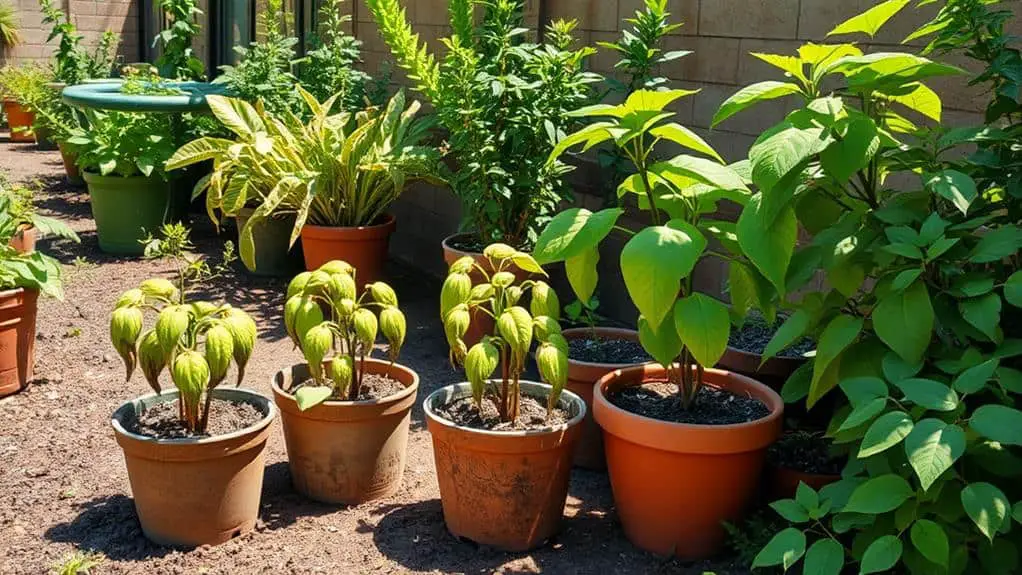
During peak summer heat, containers left in direct sunlight can wreak havoc on your plants. To avoid heat stress, consider these container placement strategies. Relocate your containers to shaded spots, especially when temperatures soar above 90°F. This move provides shaded location benefits like protecting foliage and reducing bloom loss.
Here's a quick guide:
| Time of Day | Sun Exposure | Action |
|---|---|---|
| Morning (6-10 AM) | Mild Sunlight | Keep in original spot |
| Midday (10 AM-4 PM) | Intense Sunlight | Move to shaded area |
| Evening (4-8 PM) | Cooling Down | Return to sunny spot |
| Night (8 PM-6 AM) | No Sunlight | Keep in any location |
| Throughout Day | Check Moisture | Regular watering |
Using these moisture retention techniques, guarantee soil doesn't dry out. Your plants will thank you!
Prevent Plant Transplant
After ensuring your containers are safe from the scorching sun, let's turn our attention to another critical aspect of garden care: preventing plant transplant during extreme heat.
Transplanting in hot, dry conditions can stress plants, hindering their root development and establishment. Here are some practical tips to keep in mind:
- Avoid transplanting when temperatures exceed 90°F.
- Prepare soil properly before planting, ensuring it's cool and moist.
- Wait for cooler days to transplant new flowers or shrubs.
- Monitor new plants closely and provide adequate water and shade.
- Focus on root development by ensuring the soil isn't too hot or dry.
Monitor Weather Closely
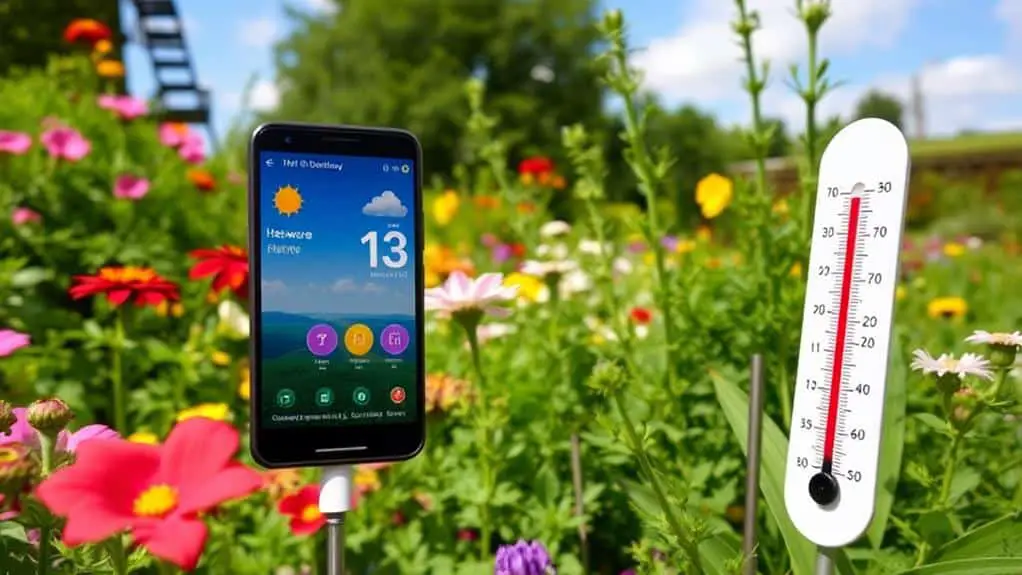
Keep an eye on the weather forecast to stay ahead of heatwaves and sudden temperature spikes, as plants can get really stressed in temperatures above 90°F.
It's important to adjust your watering schedule and avoid planting or pruning when extreme heat is expected.
Track Heatwave Patterns
Monitoring local weather forecasts is essential for any gardener aiming to protect their plants from the stress of heatwaves. By keeping an eye on heatwave patterns, I can make timely adjustments to my garden care routine.
To effectively track weather patterns, I:
- Use weather apps that provide heat index readings.
- Observe changes in my garden microclimates.
- Plan watering schedules based on upcoming heatwave effects.
- Identify the best times to mulch to maintain soil moisture.
- Delay planting or transplanting to boost plant resilience.
Staying informed about weather changes helps me guarantee my plants remain healthy and stress-free.
Prepare for Temperature Spikes
Being proactive about monitoring weather forecasts guarantees I can prepare my garden for temperature spikes effectively.
Regularly checking temperature trends helps me manage soil temperature and make certain plant drought resistance. When air temperatures rise above 90°F, I know my plants will need extra care. I use local weather stations and apps to get timely updates and adjust my watering schedule accordingly.
Tracking humidity levels is also essential, as high humidity can stress plants and promote diseases. To combat this, I focus on soil temperature management by keeping it moist and applying mulch.
Additionally, I implement shade provision strategies to protect my plants from the harsh sun. By staying informed, I can keep my garden thriving through the heat.
Anticipate Weather Changes
Anticipating weather changes is essential for maintaining a healthy garden, and I make it a habit to monitor forecasts closely.
Weather preparedness strategies and climate adaptation techniques are key to guaranteeing your garden thrives, even during a summer heatwave.
Here are some seasonal gardening tips I follow:
- Check weather forecasts regularly for heatwave alerts.
- Monitor humidity levels along with temperature to prevent plant stress and disease.
- Use local agricultural extension services or gardening apps for region-specific updates.
- Keep an eye on soil moisture levels to guarantee plants are hydrated before extreme heat hits.
- Adjust your watering schedule and apply mulch to protect plants from sudden temperature spikes.
Avoid Chemical Controls
When it comes to maintaining a healthy garden, it's vital to avoid chemical controls, especially during high temperatures. Many weed control products don't work well when it's hot, so summer applications often fail.
Plus, applying chemicals can stress your plants even more, which might harm or kill them. Instead, try using chemical alternatives like organic methods and integrated pest management. These are gentler on your plants and the environment.
Summer is also a risky time because pests and diseases are attracted to the sap flow in plants. So, it's best to hold off on chemical treatments until it cools down.
Frequently Asked Questions
How to Prepare a Garden for a Heat Wave?
To prepare your garden for a heatwave, focus on shade strategies, mulch benefits, and smart plant selection. I apply mulch to retain moisture, choose heat-tolerant plants, and provide shade to protect sensitive areas from harsh sunlight.
Should You Water Garden Before Hot Day?
Yes, water your garden in the morning. Morning watering helps plants absorb moisture before the heat hits, reducing plant stress. Check soil moisture by touch; if it's damp, you don't need to water more.
How Do I Protect My Garden From Summer Heat?
To protect my garden from summer heat, I apply mulch to retain moisture, choose heat-tolerant plants, and use shade solutions like relocating containers. These steps help maintain plant health and reduce stress during extreme temperatures.
What Temperature Is Too Hot for Garden Plants?
When temperatures consistently exceed 85°F, garden plants start experiencing stress. Their heat tolerance varies, but above 90°F, plant stress becomes severe. Soil moisture also depletes quickly, further affecting their health and growth.
Conclusion
Remember, taking these steps before a summer heatwave will help your garden thrive. By avoiding planting, skipping daily watering, holding off on pruning, and steering clear of chemical treatments, your plants will be better prepared for the heat. Keep an eye on the weather and make adjustments as needed. You've got this! With a bit of care and attention, your garden will stay healthy and beautiful all summer long. Happy gardening!



